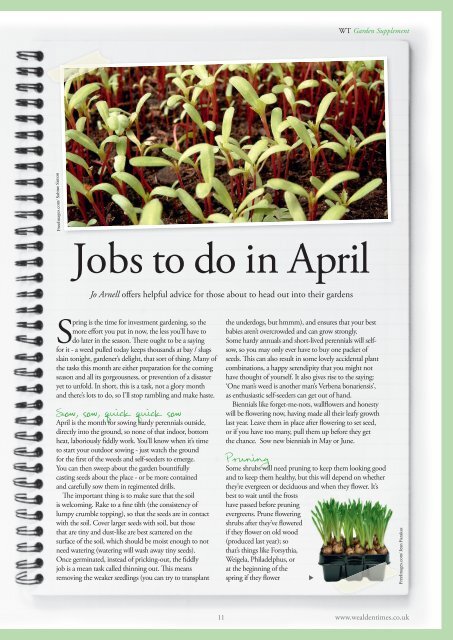Wealden Times | WT170 | April 2016 | Garden supplement inside
Wealden Times - The lifestyle magazine for the Weald
Wealden Times - The lifestyle magazine for the Weald
Create successful ePaper yourself
Turn your PDF publications into a flip-book with our unique Google optimized e-Paper software.
WT <strong>Garden</strong> Supplement<br />
FreeImages.com/ Sabine Simon<br />
Jobs to do in <strong>April</strong><br />
Jo Arnell offers helpful advice for those about to head out into their gardens<br />
Spring is the time for investment gardening, so the<br />
more effort you put in now, the less you’ll have to<br />
do later in the season. There ought to be a saying<br />
for it - a weed pulled today keeps thousands at bay / slugs<br />
slain tonight, gardener’s delight, that sort of thing. Many of<br />
the tasks this month are either preparation for the coming<br />
season and all its gorgeousness, or prevention of a disaster<br />
yet to unfold. In short, this is a task, not a glory month<br />
and there’s lots to do, so I’ll stop rambling and make haste.<br />
Sow, sow, quick quick sow<br />
<strong>April</strong> is the month for sowing hardy perennials outside,<br />
directly into the ground, so none of that indoor, bottom<br />
heat, laboriously fiddly work. You’ll know when it’s time<br />
to start your outdoor sowing - just watch the ground<br />
for the first of the weeds and self-seeders to emerge.<br />
You can then sweep about the garden bountifully<br />
casting seeds about the place - or be more contained<br />
and carefully sow them in regimented drills.<br />
The important thing is to make sure that the soil<br />
is welcoming. Rake to a fine tilth (the consistency of<br />
lumpy crumble topping), so that the seeds are in contact<br />
with the soil. Cover larger seeds with soil, but those<br />
that are tiny and dust-like are best scattered on the<br />
surface of the soil, which should be moist enough to not<br />
need watering (watering will wash away tiny seeds).<br />
Once germinated, instead of pricking-out, the fiddly<br />
job is a mean task called thinning out. This means<br />
removing the weaker seedlings (you can try to transplant<br />
the underdogs, but hmmm), and ensures that your best<br />
babies aren’t overcrowded and can grow strongly.<br />
Some hardy annuals and short-lived perennials will selfsow,<br />
so you may only ever have to buy one packet of<br />
seeds. This can also result in some lovely accidental plant<br />
combinations, a happy serendipity that you might not<br />
have thought of yourself. It also gives rise to the saying:<br />
‘One man’s weed is another man’s Verbena bonariensis’,<br />
as enthusiastic self-seeders can get out of hand.<br />
Biennials like forget-me-nots, wallflowers and honesty<br />
will be flowering now, having made all their leafy growth<br />
last year. Leave them in place after flowering to set seed,<br />
or if you have too many, pull them up before they get<br />
the chance. Sow new biennials in May or June.<br />
Pruning<br />
Some shrubs will need pruning to keep them looking good<br />
and to keep them healthy, but this will depend on whether<br />
they’re evergreen or deciduous and when they flower. It’s<br />
best to wait until the frosts<br />
have passed before pruning<br />
evergreens. Prune flowering<br />
shrubs after they’ve flowered<br />
if they flower on old wood<br />
(produced last year); so<br />
that’s things like Forsythia,<br />
Weigela, Philadelphus, or<br />
at the beginning of the<br />
spring if they flower <br />
FreeImages.com/ Jean Fazakas<br />
11 www.wealdentimes.co.uk<br />
<strong>WT170</strong>Book.indb 11 22/03/<strong>2016</strong> 12:50


















